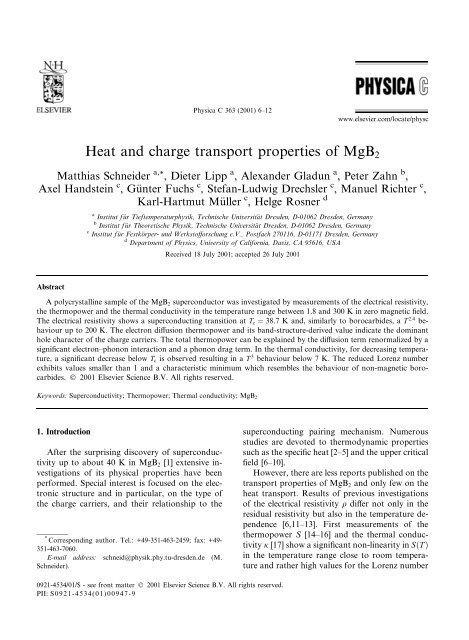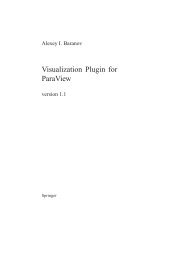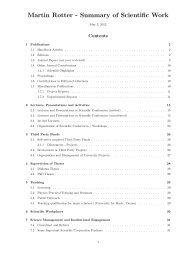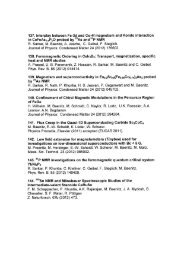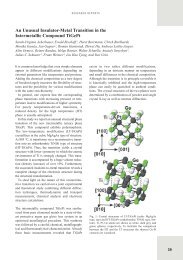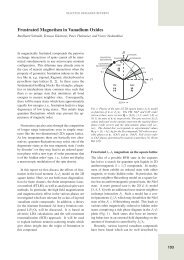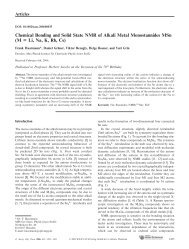Heat and charge transport properties of MgB2
Heat and charge transport properties of MgB2
Heat and charge transport properties of MgB2
You also want an ePaper? Increase the reach of your titles
YUMPU automatically turns print PDFs into web optimized ePapers that Google loves.
<strong>Heat</strong> <strong>and</strong> <strong>charge</strong> <strong>transport</strong> <strong>properties</strong> <strong>of</strong> <strong>MgB2</strong><br />
Matthias Schneider a,* , Dieter Lipp a , Alex<strong>and</strong>er Gladun a , Peter Zahn b ,<br />
Axel H<strong>and</strong>stein c ,Gunter Fuchs c , Stefan-Ludwig Drechsler c , Manuel Richter c ,<br />
Karl-Hartmut Muller c , Helge Rosner d<br />
Abstract<br />
a<br />
Institut fur Tieftemperaturphysik, Technische Universitat Dresden, D-01062 Dresden, Germany<br />
b<br />
Institut fur Theoretische Physik, Technische Universitat Dresden, D-01062 Dresden, Germany<br />
c<br />
Institut fur Festkorper- und Werksto€orschung e.V., Postfach 270116, D-01171 Dresden, Germany<br />
d<br />
Department <strong>of</strong> Physics, University <strong>of</strong> California, Davis, CA 95616, USA<br />
Received 18 July 2001; accepted 26 July 2001<br />
A polycrystalline sample <strong>of</strong> the <strong>MgB2</strong> superconductor was investigated by measurements <strong>of</strong> the electrical resistivity,<br />
the thermopower <strong>and</strong> the thermal conductivity in the temperature range between 1.8 <strong>and</strong> 300 K in zero magnetic ®eld.<br />
The electrical resistivity shows a superconducting transition at Tc ˆ 38:7 K <strong>and</strong>, similarly to borocarbides, a T 2:4 behaviour<br />
up to 200 K. The electron di€usion thermopower <strong>and</strong> its b<strong>and</strong>-structure-derived value indicate the dominant<br />
hole character <strong>of</strong> the <strong>charge</strong> carriers. The total thermopower can be explained by the di€usion term renormalized by a<br />
signi®cant electron±phonon interaction <strong>and</strong> a phonon drag term. In the thermal conductivity, for decreasing temperature,<br />
a signi®cant decrease below Tc is observed resulting in a T 3 behaviour below 7 K. The reduced Lorenz number<br />
exhibits values smaller than 1 <strong>and</strong> a characteristic minimum which resembles the behaviour <strong>of</strong> non-magnetic borocarbides.<br />
Ó 2001 Elsevier Science B.V. All rights reserved.<br />
Keywords: Superconductivity; Thermopower; Thermal conductivity; <strong>MgB2</strong><br />
1. Introduction<br />
After the surprising discovery <strong>of</strong> superconductivity<br />
up to about 40 K in <strong>MgB2</strong> [1] extensive investigations<br />
<strong>of</strong> its physical <strong>properties</strong> have been<br />
performed. Special interest is focused on the electronic<br />
structure <strong>and</strong> in particular, on the type <strong>of</strong><br />
the <strong>charge</strong> carriers, <strong>and</strong> their relationship to the<br />
*<br />
Corresponding author. Tel.: +49-351-463-2459; fax: +49-<br />
351-463-7060.<br />
E-mail<br />
Schneider).<br />
address: schneid@physik.phy.tu-dresden.de �M.<br />
Physica C 363 �2001) 6±12<br />
0921-4534/01/$ - see front matter Ó 2001 Elsevier Science B.V. All rights reserved.<br />
PII: S0921-4534�01)00947-9<br />
www.elsevier.com/locate/physc<br />
superconducting pairing mechanism. Numerous<br />
studies are devoted to thermodynamic <strong>properties</strong><br />
such as the speci®c heat [2±5] <strong>and</strong> the upper critical<br />
®eld [6±10].<br />
However, there are less reports published on the<br />
<strong>transport</strong> <strong>properties</strong> <strong>of</strong> <strong>MgB2</strong> <strong>and</strong> only few on the<br />
heat <strong>transport</strong>. Results <strong>of</strong> previous investigations<br />
<strong>of</strong> the electrical resistivity q di€er not only in the<br />
residual resistivity but also in the temperature dependence<br />
[6,11±13]. First measurements <strong>of</strong> the<br />
thermopower S [14±16] <strong>and</strong> the thermal conductivity<br />
j [17] show a signi®cant non-linearity in S…T †<br />
in the temperature range close to room temperature<br />
<strong>and</strong> rather high values for the Lorenz number
derived from the reported data <strong>of</strong> j…T † <strong>and</strong> q…T †.<br />
Such measurements are <strong>of</strong> general interest since<br />
they provide additional insight into the electronic<br />
structure <strong>and</strong> the electron±phonon �el±ph) interaction.<br />
In the present paper, zero magnetic ®eld<br />
measurements <strong>of</strong> thermal <strong>and</strong> <strong>charge</strong> <strong>transport</strong><br />
<strong>properties</strong> <strong>of</strong> <strong>MgB2</strong> are reported. Since at present<br />
the pairing mechanism has not been settled yet the<br />
comparison with related superconductors might be<br />
helpful to elucidate further details <strong>of</strong> the superconductivity<br />
in <strong>MgB2</strong>. In this context also similarities<br />
<strong>and</strong> di€erences with the behaviour <strong>of</strong> well<br />
studied non-magnetic borocarbides will be discussed.<br />
2. Experimental details<br />
The experiments were performed on a polycrystalline<br />
sample <strong>of</strong> <strong>MgB2</strong> <strong>of</strong> about 5 1:2 1:2<br />
mm 3 . It was cut from a pellet which was prepared<br />
by a conventional solid state reaction as described<br />
elsewhere [7]. The X-ray di€raction pattern<br />
<strong>of</strong> powder ground from this sample batch have<br />
shown that the material is single phased.<br />
To investigate the thermopower S, two copper<br />
wires were ®xed to the sample by an electrically<br />
conducting epoxy resin. The temperature gradient<br />
along the sample <strong>of</strong> about 1% <strong>of</strong> the temperature<br />
was generated by a small strain gauge heater. The<br />
temperature di€erences between the copper wires<br />
<strong>and</strong> between sample <strong>and</strong> cold copper plate were<br />
measured by two AuFe±Chromel thermocouples,<br />
the absolute temperature was detected by a germanium<br />
<strong>and</strong> at higher values by a platinum thermometer.<br />
The thermal conductivity j was measured by<br />
the st<strong>and</strong>ard steady-state method. For a ®rst measurement<br />
up to 100 K the thermocouples were<br />
®xed directly to the sample by a low-temperature<br />
varnish. The same varnish was used to connect<br />
the sample with the cold copper plate. A second<br />
measurement, with a better contact by electrically<br />
conducting epoxy resin Eccobond 56C, was performed<br />
together with the investigation <strong>of</strong> S. No<br />
signi®cant deviations between both results were<br />
found.<br />
M. Schneider et al. / Physica C 363 �2001) 6±12 7<br />
The electrical resistance was measured by the<br />
usual four probe method. Unfortunately, the attempt<br />
to ®x additional current contacts to the<br />
sample prepared for the thermal conductivity<br />
measurement failed. Therefore, the electrical resistivity<br />
q was determined in a separate run, resulting<br />
in higher errors for the reduced Lorenz<br />
number because <strong>of</strong> the higher uncertainty in the<br />
distance between the voltage leads.<br />
3. Results <strong>and</strong> discussion<br />
As shown in Fig. 1, the resistivity <strong>of</strong> the investigated<br />
sample decreases from room temperature<br />
down to 40 K from a value <strong>of</strong> 38.2 to 7.1 lXcm,<br />
i.e. the resistivity ratio RRR amounts to 5.4. According<br />
to the uncertainties <strong>of</strong> the cross-section <strong>of</strong><br />
the sample <strong>and</strong> the distance between the voltage<br />
contacts, the error <strong>of</strong> the q values is about 20%;<br />
the uncertainty <strong>of</strong> RRR is much smaller. Muller<br />
et al. reported RRR ˆ 4:5 for another sample cut<br />
from the same pellet [7]. A sharp superconducting<br />
transition is found at 38.7 K �midpoint value <strong>of</strong><br />
the normal-state resistivity).<br />
To analyse the temperature dependence <strong>of</strong> q…T †,<br />
the normal-state data below 200 K can be ®tted to<br />
the expression<br />
q…T †ˆq 0 ‡ aT b ; …1†<br />
rather than to a Bloch±Gruneisen formula as<br />
proposed by Gasparov et al. [13]. Fig. 2 shows the<br />
Fig. 1. Temperature dependence <strong>of</strong> the electrical resistivity q <strong>of</strong><br />
<strong>MgB2</strong>. The inset shows the range near Tc.
8 M. Schneider et al. / Physica C 363 �2001) 6±12<br />
Fig. 2. Resistivity q <strong>of</strong> <strong>MgB2</strong> plotted as a function <strong>of</strong> T 2:4 . The<br />
plotted range corresponds to Tc < T < 200 K.<br />
results in the temperature range between Tc <strong>and</strong><br />
200 K. The parameter values obtained from this ®t<br />
are q 0 ˆ 6:8 lX cm, a ˆ 3:3 10 5 lX cm/K b <strong>and</strong><br />
b ˆ 2:4. The obtained value <strong>of</strong> the exponent is in<br />
between the reported results b ˆ 2 [12] <strong>and</strong> b ˆ 3<br />
[6] <strong>and</strong> in good agreement with b ˆ 2:6 for a<br />
dense <strong>MgB2</strong> wire [11]. It is noteworthy that a<br />
similar behaviour was also found for other superconducting<br />
compounds. Rathnayaka et al. [18]<br />
reported exponents b <strong>of</strong> 2.2 <strong>and</strong> 2.0 for YNi2B2C<br />
<strong>and</strong> LuNi2B2C single crystals, respectively. In the<br />
temperature range 200 K < T < 300 K the curvature<br />
<strong>of</strong> q…T † <strong>of</strong> <strong>MgB2</strong> decreases with increasing<br />
temperature <strong>and</strong> seems to follow the Bloch±<br />
Gruneisen formula.<br />
The thermopower <strong>of</strong> <strong>MgB2</strong> is shown in Fig. 3.<br />
The room temperature value <strong>of</strong> 8.7 lV/K is in<br />
good agreement with the data <strong>of</strong> Lorenz et al. [14]<br />
who reported a value <strong>of</strong> about 8.3 lV/K for a<br />
<strong>MgB2</strong> sample with a RRR <strong>of</strong> about 3. Furthermore,<br />
the value for the slope <strong>of</strong> 0.036 lV/K 2 , ®tted<br />
to the measured data in the range 40 K <<br />
T < 160 K, is close to the reported dS=dT ˆ<br />
0:042 lV/K 2 below 160 K [14].<br />
A quite smooth behaviour <strong>of</strong> the thermopower<br />
with a small jump <strong>of</strong> about 0.3 lV/K was found<br />
at the cross-over from the superconducting to the<br />
normal state. Lorenz et al. reported a higher jump<br />
<strong>of</strong> about 0.7 lV/K [14]. Further investigations <strong>of</strong><br />
high quality very pure samples are required to<br />
clarify this issue.<br />
Fig. 3. Thermopower S <strong>of</strong> <strong>MgB2</strong> in the temperature range<br />
between 4 <strong>and</strong> 300 K. The straight line represents a linear ®t to<br />
the data in the range 40 K < T < 160 K. The inset shows the<br />
product <strong>of</strong> thermopower <strong>and</strong> temperature as a function <strong>of</strong> T 2 in<br />
the whole measured range. The straight line in the inset represents<br />
a ®t according to Eq. �2) to the data in the range<br />
70 K < T < 270 K.<br />
The data can be described by the expression<br />
S…T †ˆ A<br />
‡ BT ; …2†<br />
T<br />
where A=T is the phonon drag term <strong>and</strong> BT the<br />
electron di€usion term. In the range 70 K <<br />
T < 270 K, for B a value <strong>of</strong> 0:031 lV/K 2 is observed.<br />
The positive sign <strong>of</strong> B is an indication <strong>of</strong><br />
the hole character <strong>of</strong> the <strong>charge</strong> carriers [19±21].<br />
For A, the ®t yields a value <strong>of</strong> about 60 lV. For<br />
temperatures below 70 K a systematic deviation<br />
from the behaviour according to Eq. �2) is found<br />
since the expression A=T is valid only at the hightemperature<br />
side <strong>of</strong> the phonon drag peak. Above<br />
270 K, a sublinear behaviour <strong>of</strong> ST vs. T 2 is<br />
observed as reported by Lorenz et al. [14]. The<br />
di€erent magnitude <strong>of</strong> this deviation might be attributed<br />
to di€erences in the samples.<br />
To get some microscopic insight into the magnitude<br />
<strong>of</strong> the second term <strong>of</strong> Eq. �2), we have<br />
also performed a theoretical calculation <strong>of</strong> the<br />
electronic part using local density approximation<br />
�LDA) b<strong>and</strong> structure calculations �FPLO code<br />
[23]) <strong>and</strong> employing the well-known Mott formula,<br />
renormalized by the el±ph interaction coupling<br />
constant kel±ph [24]:
Sel ˆ p2 k 2 B T<br />
3e<br />
o ln r…e†<br />
…1 ‡ kel±ph…T ††: …3†<br />
oe eˆEF<br />
Here for the sake <strong>of</strong> simplicity only the energy<br />
dependence <strong>of</strong> the conductivity r…e† in the relaxation<br />
time approximation has been taken into<br />
account ignoring a possible energy dependence <strong>of</strong><br />
the scattering rates. Thus we obtain a value <strong>of</strong><br />
about 2.8 lV/K …1 ‡ kel±ph† at room temperature.<br />
First <strong>of</strong> all the correct sign �which corresponds<br />
to a dominant hole contribution) should be<br />
noted. Then, adopting a strong el±ph interaction<br />
kel±ph 2 we would arrive approximately at the<br />
experimental results 8 lV/K. This is in qualitative<br />
accord with the intermediate to strong coupling<br />
scenario proposed in Ref. [10]. However, a<br />
more detailed investigation <strong>of</strong> each Fermi surface<br />
sheet <strong>and</strong> <strong>of</strong> the coupling to various phonon<br />
�boson) modes are required to extract quantitatively<br />
the strength <strong>of</strong> the el±ph interaction in a<br />
more reliable manner. In this context a possible<br />
relation <strong>of</strong> the �decreasing) temperature dependence<br />
<strong>of</strong> kel±ph…T † at high temperatures to the observed<br />
deviation from the behaviour according to<br />
Eq. �2) above 270 K is worth to be studied in more<br />
detail.<br />
For YNi2B2C <strong>and</strong> LuNi2B2C the electron diffusion<br />
term is smaller <strong>and</strong> negative: For YNi2B2C,<br />
a value <strong>of</strong> about 0.007 lV/K 2 [22] is reported.<br />
Furthermore, much higher negative phonon drag<br />
contributions in borocarbides have been found<br />
resulting in values for A between 450 <strong>and</strong> 550<br />
lV [22]. Thus, the phonon drag contribution is less<br />
pronounced in <strong>MgB2</strong> than in YNi2B2C.<br />
The results <strong>of</strong> the thermal conductivity measurements<br />
are presented in Fig. 4. The data taken<br />
in two separate runs as described above lie on top<br />
up <strong>of</strong> each other. Nevertheless, the error <strong>of</strong> the<br />
absolute value is about 20%, mainly caused by the<br />
uncertainties <strong>of</strong> cross-section <strong>and</strong> distance between<br />
thermometers.<br />
The measured values <strong>of</strong> j at 300 K are about<br />
20% smaller than those reported by Bauer et al.<br />
[17] resulting from uncertainties in the measurements<br />
<strong>and</strong> possible di€erences in the samples. The<br />
positive slope <strong>of</strong> j…T † in the whole investigated<br />
temperature range indicates the limitation <strong>of</strong> the<br />
heat conductivity by crystal defects as in pure<br />
M. Schneider et al. / Physica C 363 �2001) 6±12 9<br />
Fig. 4. Thermal conductivity j <strong>of</strong> <strong>MgB2</strong> in the temperature<br />
range between 1.8 <strong>and</strong> 300 K in a double logarithmic plot. The<br />
straight line represents a T 3 ®t to the data at low temperatures.<br />
normal metals j exhibits a maximum at lower<br />
temperatures <strong>and</strong> then decreases to a constant<br />
value with rising temperature.<br />
No kink anomaly <strong>of</strong> j could be detected at the<br />
superconducting phase transition as reported for<br />
the non-magnetic borocarbides [25,26]. The additionally<br />
observed peak below Tc in j…T † <strong>of</strong> these<br />
compounds should not be regarded as a generic<br />
intrinsic feature <strong>of</strong> clean superconductors since<br />
investigations <strong>of</strong> niobium samples exhibit such<br />
a peak only for medium clean samples �RRR<br />
3000) while it disappears, if the sample quality is<br />
further increased to RRR 33000 [27]. Furthermore,<br />
the reduction <strong>of</strong> a possible peak is in agreement<br />
with the high phonon velocities in <strong>MgB2</strong><br />
[26,28].<br />
According to the decrease <strong>of</strong> the electronic<br />
thermal conductivity below Tc a signi®cant change<br />
in the slope <strong>of</strong> j…T † is found. Below 7 K, where the<br />
in¯uence <strong>of</strong> the electrons is negligible, the expected<br />
T 3 law for j…T † dominated by phonons at low<br />
temperatures is observed. With the measured value<br />
<strong>of</strong> j=T 3 ˆ 2:9 10 3 W/K4m a mean free path l <strong>of</strong><br />
the phonons at low temperatures can be calculated:<br />
j…T † 1<br />
l ˆ 3<br />
c…T † v VM; …4†<br />
where c is the speci®c heat, v the acoustic sound<br />
velocity, <strong>and</strong> VM the molar volume. For the lattice<br />
contribution <strong>of</strong> the speci®c heat c…T † a coe cient
10 M. Schneider et al. / Physica C 363 �2001) 6±12<br />
b ˆ c=T 3 ˆ 1:04 10 5 J/K 4 mol was reported [3].<br />
Using the calculated values for the sound velocity<br />
<strong>of</strong> v ˆ 10 600 m/s for a longitudinal wave [28] <strong>and</strong><br />
a molar volume <strong>of</strong> VM ˆ 17:5 cm 3 /mol as derived<br />
from the unit cell volume <strong>of</strong> V ˆ 29:02 A 3 [29], Eq.<br />
�4) yields l ˆ 1:4 lm. This length can be interpreted<br />
as an averaged grain size <strong>and</strong> is in agreement<br />
with the results <strong>of</strong> optical investigations <strong>of</strong><br />
the pellets.<br />
The reduced Lorenz number<br />
L…T †<br />
ˆ<br />
L0<br />
j…T †q…T †<br />
; …5†<br />
L0T<br />
where L0 ˆ 2:44 10 8 WX/K 2 is the Sommerfeld<br />
value, was derived from the measured values <strong>of</strong><br />
j…T † <strong>and</strong> q…T †. The results are shown in Fig. 5.<br />
The error is about 30%.<br />
At least for temperatures below 250 K the reduced<br />
Lorenz number is signi®cantly smaller than<br />
the expected value <strong>of</strong> 1. Similar results shown in<br />
the inset <strong>of</strong> Fig. 5 were found for typical nonmagnetic<br />
borocarbides [25,26] <strong>and</strong> interpreted as<br />
the in¯uence <strong>of</strong> inelastic scattering on the electronic<br />
thermal conductivity. The very small values<br />
<strong>of</strong> the Lorenz number con®rm the dominating role<br />
<strong>of</strong> the electronic contribution to the heat <strong>transport</strong>.<br />
Noteworthy, the shape <strong>of</strong> the Lorenz plots for<br />
<strong>MgB2</strong> <strong>and</strong> YNi2B2C/LuNi2B2C is very similar.<br />
Fig. 5. Reduced Lorenz number L=L0 <strong>of</strong> <strong>MgB2</strong> in the temperature<br />
range between 40 <strong>and</strong> 300 K. The inset shows the reduced<br />
Lorenz number <strong>of</strong> YNi2B2C <strong>and</strong> LuNi2B2C single crystals <strong>of</strong><br />
the in-plane heat <strong>and</strong> <strong>charge</strong> <strong>transport</strong> <strong>properties</strong> taken from<br />
Refs. [25,26].<br />
Furthermore, the minima in the reduced Lorenz<br />
number occur at temperatures <strong>of</strong> about 120 <strong>and</strong><br />
35 K for <strong>MgB2</strong> <strong>and</strong> YNi2B2C/LuNi2B2C, respectively.<br />
These values correspond to 2±3Tc for that<br />
compounds.<br />
Di€erent from these results, the published<br />
data <strong>of</strong> electrical resistivity <strong>and</strong> thermal conductivity<br />
<strong>of</strong> Bauer et al. [17] yield reduced Lorenz<br />
numbers <strong>of</strong> up to about 2.5 at room temperature<br />
mainly caused by the high resistivity values. Their<br />
reported q…300 K† 70 lX cm is about twice as<br />
high as the value found here. Further investigations<br />
are required to clarify these di€erences in L.<br />
However, their reduced Lorenz number shows a<br />
similar behaviour with a minimum at about 120 K.<br />
To summarize, in addition to a number <strong>of</strong> wellknown<br />
similarities in the superconducting <strong>properties</strong><br />
<strong>of</strong> <strong>MgB2</strong> <strong>and</strong> YNi2B2C, in the present work<br />
also similarities related to the normal-state <strong>transport</strong><br />
<strong>properties</strong> have been found in the temperature<br />
dependences <strong>of</strong> the resistivity <strong>and</strong> <strong>of</strong> the<br />
reduced Lorenz number. However, the positive<br />
sign <strong>of</strong> the thermopower as observed in the measurement<br />
<strong>and</strong> derived from b<strong>and</strong> structure calculations<br />
indicates a dominant hole contribution in<br />
<strong>MgB2</strong>. The magnitude <strong>of</strong> the thermopower might<br />
indicate an intermediate to strong el±ph coupling<br />
scenario. The thermal conductivity strongly deviates<br />
from the behaviour expected for clean samples.<br />
The averaged grain size <strong>of</strong> the sample inferred<br />
from this measurement is about 1:4 lm.<br />
After completion [30] <strong>of</strong> the present work, we<br />
have learnt about a preprint by Putti et al. [31].<br />
Their resistivity data di€er from ours by a signi-<br />
®cantly higher residual resistivity <strong>and</strong> a smaller<br />
RRR value. The data have been described by a<br />
generalized Bloch±Gruneisen formula. The raw<br />
thermopower data S…T † looks very similar to ours.<br />
However, the interpretation is di€erent. In the<br />
narrow interval 45 K < T < 90 K S…T † was ®tted<br />
to a linear term Sel <strong>and</strong> a positive cubic one �i.e. the<br />
low-temperature approximation for the phonon drag<br />
contribution) which would point to predominant<br />
N �normal) scattering processes at low temperature.<br />
The high-temperature region was not quantitatively<br />
analysed. Our data can be analysed by<br />
those terms only in the range 55 K < T < 90 K with<br />
clear deviations above 90 K <strong>and</strong> also below 55 K.
Anyhow, this should be compared with our ®t �Eq.<br />
�2)) in a broader interval 70 K < T < 270 K. It<br />
contains a negative high-temperature approximation<br />
for the phonon drag contribution which can<br />
be interpreted in terms <strong>of</strong> U �Umklapp) processes<br />
[20] <strong>and</strong> the relevance <strong>of</strong> s<strong>of</strong>t modes clearly below<br />
the Debye energy. In this context the observation<br />
<strong>of</strong> low energy peaks at about 16 <strong>and</strong> 24 meV in<br />
recent neutron scattering [32] <strong>and</strong> 17 meV in Raman<br />
measurements [33] is <strong>of</strong> interest. Naturally,<br />
due to these di€erent adopted approximations for<br />
the phonon drag terms with opposite signs, different<br />
dressed linear electronic di€usion terms<br />
Sel=T ˆ B ˆ 0:0176 lV/K 2 <strong>and</strong> B ˆ 0:031 lV/K 2<br />
have been derived. Since the b<strong>and</strong> structure result<br />
for the bare Sel-term, calculated in the same approximation<br />
for the scattering rate as we did,<br />
seems to coincide with our result, di€erent renormalizations<br />
due to many-body e€ects would be<br />
expected.<br />
Furthermore, Muranaka et al. [34] reported a<br />
saturation <strong>of</strong> the thermopower near room temperature<br />
at a relatively low level <strong>of</strong> only 4 lV/K<br />
�compared with about 8 lV/K in our work or in<br />
Ref. [31]) <strong>and</strong> a reduced Lorenz number with a<br />
similar shape <strong>and</strong> a magnitude in between that <strong>of</strong><br />
Bauer et al. [17] <strong>and</strong> that <strong>of</strong> the present work. All<br />
these di€erent features mentioned above require<br />
further investigations especially with respect to the<br />
sample quality.<br />
Acknowledgements<br />
This work has been supported by the SFB 463,<br />
the DFG, the DAAD �individual grant, H.R.), <strong>and</strong><br />
the ONR grant no. N00017-97-1-0956. We acknowledge<br />
valuable discussions with S.V. Shulga,<br />
I. Mertig, <strong>and</strong> H. Eschrig.<br />
References<br />
[1] J. Nagamatsu, N. Nakagawa, T. Muranaka, Y. Zenitani,<br />
J. Akimitsu, Nature 410 �2001) 63.<br />
[2] S.L. Budko, G. Lapertot, C. Petrovic, C.E. Cunningham,<br />
N. Anderson, P.C. Can®eld, Phys. Rev. Lett. 86 �2001) 1877.<br />
[3] R.K. Kremer, B.J. Gibson, K. Ahn, cond-mat/0102432.<br />
[4] Ch. Walti, E. Felder, C. Degen, G. Wigger, R. Monnier, B.<br />
Delley, H.R. Ott, cond-mat/0102522.<br />
M. Schneider et al. / Physica C 363 �2001) 6±12 11<br />
[5] A. Junod, Y. Wang, F. Bouquet, P. Toulemonde, condmat/0106394,<br />
<strong>and</strong> references therein.<br />
[6] D.K. Finnemore, J.E. Ostenson, S.L. Budko, G. Lapertot,<br />
P.C. Can®eld, Phys. Rev. Lett. 86 �2001) 2420.<br />
[7] K.-H. Muller, G. Fuchs, A. H<strong>and</strong>stein, K. Nenkov, V.N.<br />
Narozhnyi, D. Eckert, M. Wolf, L. Schultz, J. Alloys<br />
Comp. 322 �2001) L10.<br />
[8] A. H<strong>and</strong>stein, D. Hinz, G. Fuchs, K.-H. Muller, K.<br />
Nenkov, O. Gut¯eisch, V.N. Narozhnyi, L. Schultz, condmat/0103408.<br />
[9] G. Fuchs, K.-H. Muller, A. H<strong>and</strong>stein, K. Nenkov, V.N.<br />
Narozhnyi, D. Eckert, M. Wolf, L. Schultz, Solid State<br />
Commun., in press, cond-mat/0104088.<br />
[10] S.V. Shulga, S.-L. Drechsler, H. Rosner, H. Eschrig, W.E.<br />
Pickett, cond-mat/0103154.<br />
[11] P.C. Can®eld, D.K. Finnemore, S.L. Budko, J.E. Ostenson,<br />
G. Lapertot, C.E. Cunningham, C. Petrovic, Phys.<br />
Rev. Lett. 86 �2001) 2423.<br />
[12] C.U. Jung, M.-S. Park, W.N. Kang, M.-S. Kim, K.H.P.<br />
Kim, S.Y. Lee, S.-I. Lee, Appl. Phys. Lett. 78 �2001) 4157,<br />
<strong>and</strong> references therein.<br />
[13] V.A. Gasparov, N.S. Sidorov, I.I. Zver'kova, M.P. Kulakov,<br />
cond-mat/0104323.<br />
[14] B. Lorenz, R.L. Meng, C.W. Chu, cond-mat/0102264;<br />
B. Lorenz, R.L. Meng, Y.Y. Xue, C.W. Chu, cond-mat/<br />
0104041.<br />
[15] W. Liu, J. Huang, Y. Wang, X. Wang, Q. Feng, S. Yan,<br />
Solid State Commun. 118 �2001) 575.<br />
[16] E.S. Choi, W. Kang, J.Y. Kim, M.-S. Park, C.U. Jung,<br />
H.-J. Kim, S.-I. Lee, cond-mat/0104454.<br />
[17] E. Bauer, Ch. Paul, St. Berger, S. Majumdar, H. Michor,<br />
M. Giovannini, A. Saccone, A. Bianconi, cond-mat/<br />
0104203.<br />
[18] K.D.D. Rathnayaka, A.K. Bhatnagar, A. Parasiris, D.G.<br />
Naugle, P.C. Can®eld, B.K. Cho, Phys. Rev. B 55 �1997)<br />
8506.<br />
[19] R.D. Barnard, Thermoelectricity in Metals <strong>and</strong> Alloys,<br />
Taylor <strong>and</strong> Francis, London, 1972.<br />
[20] F.J. Blatt, P.A. Schroeder, C.L. Foiles, D. Greig, Thermoelectric<br />
Power <strong>of</strong> Metals, Plenum, New York, 1976.<br />
[21] J.E. Hirsch, F. Marsiglio, cond-mat/0102479.<br />
[22] I.R. Fisher, J.R. Cooper, R.J. Cava, Phys. Rev. B 52 �1995)<br />
15086.<br />
[23] K. Koepernik, H. Eschrig, Phys. Rev. B 59 �1999) 1743.<br />
[24] A.B. Kaiser, C. Uher, in: A. Narlikar �Ed.), Studies <strong>of</strong><br />
High Temperature Superconductors, vol. 7, Nova Science<br />
Publishers, New York, 1991, p. 353.<br />
[25] M. Sera, S. Kobayash, M. Hiroi, N. Kobayashi, H.<br />
Takeya, K. Kadowaki, Phys. Rev. B 54 �1997) 3062.<br />
[26] E. Boaknin, R.W. Hill, C. Lupien, L. Taillefer, P.C.<br />
Can®eld, Physica C 341±348 �2000) 1845.<br />
[27] A. Gladun, C. Gladun, M. Knorn, H. Vinzelberg, J. Low<br />
Temp. Phys. 27 �1977) 873.<br />
[28] P. Ravindran, P. Vajeeston, R. Vidya, A. Kjekshus, H.<br />
Fjellvag, cond-mat/0104253.<br />
[29] J.D. Jorgensen, D.G. Hinks, S. Short, Phys. Rev. B 63<br />
�2001) 224.
12 M. Schneider et al. / Physica C 363 �2001) 6±12<br />
[30] Preliminarily version <strong>of</strong> the present work: M. Schneider, D.<br />
Lipp, A. Gladun, P. Zahn, A. H<strong>and</strong>stein, G. Fuchs, S.-L.<br />
Drechsler, M. Richter, K.-H. Muller, H. Rosner. condmat/0105429v1.<br />
[31] M. Putti, E. Galleani d'Agliano, D. Marre, F. Napoli, M.<br />
Tassisto, P. Manfrinetti, A. Palenzona, C. Rizzuto, S.<br />
Massidda. cond-mat/0106344.<br />
[32] T. Muranaka, S. Margadonna, I. Maurin, K. Brigatti, D.<br />
Colognesi, K. Prassides, Y. Iwasa, M. Arai, M. Takata,<br />
J. Akimitsu, J. Phys. Soc. Jpn. 70 �2001) 1480.<br />
[33] D. Lampakis, A. Tatsi, E. Liarokapis, G. Varelogiannis, P.M.<br />
Oppeneer, M. Pissas, T. Nishizaki. cond-mat/0105447, 2001.<br />
[34] T. Muranaka, J. Akimitsu, M. Sera, Phys. Rev. B 64 �2001)<br />
020505.


